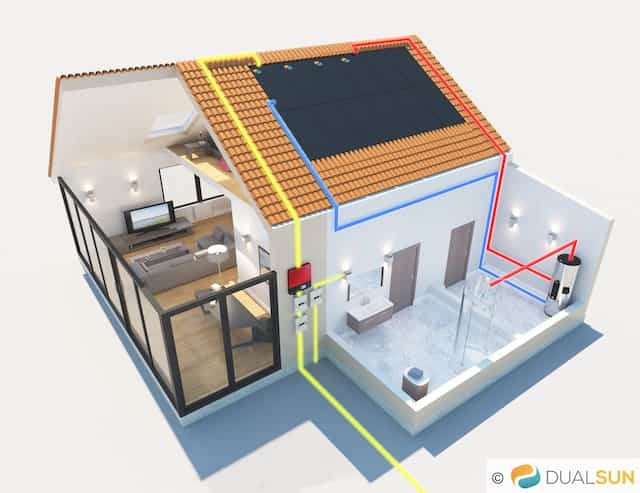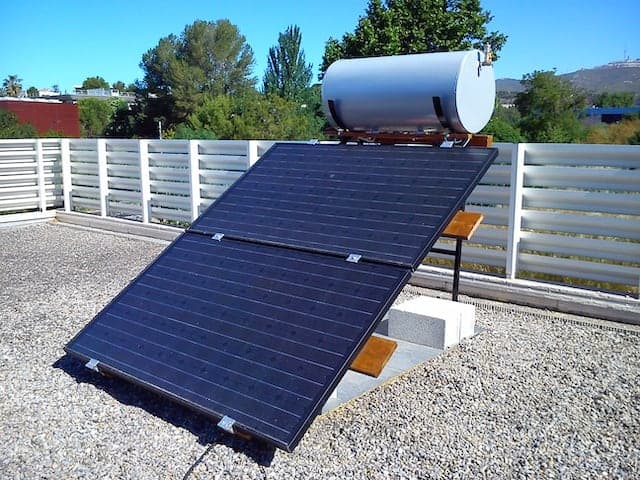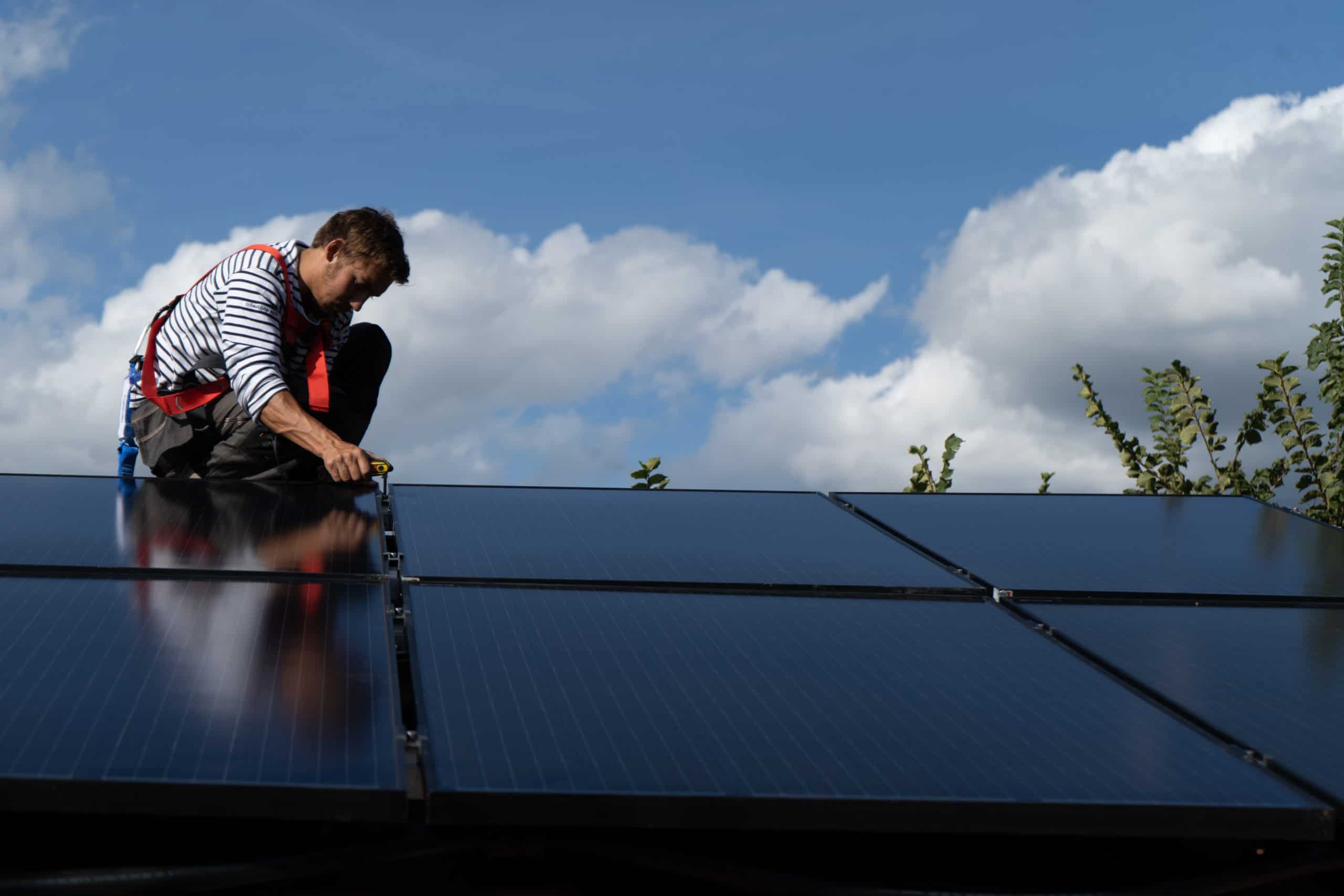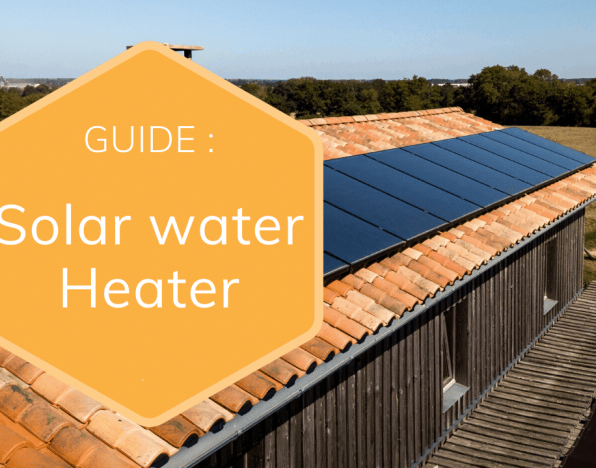Did you know that heating water is a household’s second highest electric utility cost after heating the house itself? In light of this fact, it is necessary to consider other more cost-effective and environmentally-friendly heating solutions. The solar water heater is one such solution.
Producing solar hot water is the number one purpose of a solar water heater kit.
If you are looking for a valuable resource to facilitate your search, look no further than this solar water heater guide.
—
SUMMARY
- What is a solar water heater?
- Utility, efficiency, and price of a solar water heater
- The different types of solar water heaters
- How does a solar water heater work?
- How a solar water heater works
- How to install a solar water heater
What is a solar water heater?
A solar water heater (SWH) is a domestic hot water production system that runs on thermal solar energy. Its operating principle is fairly simple.
First off, the solar panels absorb solar radiation. Afterwards, this absorbed energy heats the heat-transfer fluid behind the panel. Lastly, the heat exchanger transfers the renewable hot water to the solar tank.
It is important to note that a “solar water heater” differs from a thermodynamic water heater (which is similar to a heat pump). As such, it absorbs heat from indoor or outdoor air and uses it to warm up the water in the tank. It can be coupled with a solar installation, like in the case of our ECH20 offer.
Utility, efficiency, and price of a solar water heater
Advantages
There are several reasons to install a solar water heater:
- Firstly, to make substantial savings on your energy bill. The ADEME (French Environment and Energy Management Agency) claims that a solar hot water tank connected to solar panels can meet 50 to 80% of annual hot water needs. However, the level of autonomy you can attain depends on the region you live in. But rest assured that France receives enough sun to meet your solar hot water needs!
- Secondly, to limit your environmental impact. This is a very energy-efficient system because the circulator is the only component that consumes electricity. So the solar water heater does not emit any CO2. Thus, depending on the auxiliary heating system that you opt for, you can limit greenhouse gas emissions by 45 to 70%.
- Thirdly, to benefit from a reliable and robust technology. Provided that the solar panels are properly utilized and maintained, their lifespan can exceed 25 years. Our Dualsun panels come with a 10-year warranty. The storage tank has a service lifespan of 15 to 20 years, while the temperature sensors, the regulation, and the circulator have an average lifespan of 10 years.
How do you know when the time has come to replace a hot water tank with a solar water heater?
As soon as you find that you are spending too much on hot water (and heating).
The cost of using an electric water heater greatly varies depending on the number of people in a household. For instance, a family of 3 will spend €400 to 500 a year on bills related to the hot water tank (apart from the service contract). A solar water heater can help you drastically reduce this annual charge.

However, homes are sometimes already equipped with a heating system. This can be an air-to-water heat pump, a pellet boiler, a gas boiler or even an oil-fired boiler.
Note that some heating systems are compatible with a solar water heating panel. This is not the case for the above-mentioned systems. Only hot water tanks equipped with a solar exchanger at the bottom of the tank are compatible with panels.
The above-listed cases require the integration of an auxiliary hydraulic system or a separate auxiliary system.
Proper sizing
It is important to properly size your installation by procuring the right number of solar collectors and an adequately-sized tank.
There is no point in mounting too many thermal solar panels on a roof. Here are a few reasons why:
- Because it leads to an unnecessary additional cost
- Because it can limit solar output. The heat exchange only begins when the panel is hotter than the water in the tank. Hence the importance of emptying the tank (showers, etc.) to activate the system!
- To avoid overheating the system
Likewise, there is no reason to procure an excessively large tank. If it is too large, the stored water will not be used and the auxiliary system will work on maintaining the temperature of the unused water, causing unnecessary electricity expenses.
Consult the following article to learn more about the subject: How to select the right water tank size
Here is a summary table to help you size your Individual Solar Water Heater system. For reference, the average domestic hot water consumption per adult is an estimated 50 liters per day, at 40°C.
Source: Ademe
*Note that the equivalent of a solar panel in m2 is 1.6 m2.
Thermal efficiency
Put simply, the efficiency of a thermal solar panel is the percentage of solar radiation transformed into usable thermal energy.
It is generally found that, depending on where you live, a conventional thermal solar installation produces between 500 and 700 kWh/m²/year on average (Source: Ademe). This corresponds to the energy equivalent of 50 to 70 liters of fuel oil per m2 of installed solar panels!
Therefore, the average daily output is between 2.4 to 3.4 kWh/m² in northern France and 3.4 to 4.4 kWh/m² in southern France.
It must be noted that the efficiency of a thermal solar panel depends on the amount of sunshine in the region, its hot water requirements, and the installation of the system.
For more information on this topic, consult our article: Solar panel efficiency and output
What savings can be made?
The guide to “heating more cheaply and effectively” (French) states that “heating represents 67% of a household’s energy consumption while domestic hot water production represents 10%”.
So there are considerable savings to be made with solar energy!
A note to those interested: a solar water heater can meet 50 to 70% of your household’s annual hot water needs and save you just as much on utility bills.
In France, for example, a medium solar water heater can cover hot water needs to the following extents:
- 50% in Lille
- 56% in Paris
- 66% in Bordeaux
- 75% in Marseille
Although it contributes to a significant reduction in electricity consumption, the Individual Solar Water Heater cannot fulfill 100% of a household’s hot water needs.
Therefore, an auxiliary system must be integrated into the tank. Oftentimes, an electrical resistor takes over from the solar panels. Remember to contact your energy provider and switch to the peak/off-peak hour option! Note also that in order to attain 90% autonomy, some people choose to connect their system to a thermodynamic tank.
What is the price of a solar water heater in 2020?
Put simply, the price of the simple and double can vary depending on the selected configuration. Likewise, the required number of solar panels differs from the north to the south.
Consider the case of a 4-member family, a 200 to 300 L tank, and 3 to 5 m2 of thermal collectors. According to a study conducted by ADEME, the installation of a solar water heater and the mounting of the thermal solar panels can cost between 3,800 and €5,500 excluding tax.
Therefore, the average price of a solar water heater is around €4,650.
The different types of solar water heaters
You can opt for either thermal or hybrid solar panels.
Let us take a closer look at the two types of solar panels that can produce hot water.
Thermal or hybrid solar panels: Both of them produce hot water and can be put to use within two systems:
- The Individual Solar Water Heater system (Chauffe Eau Solaire Individuel – CESI in French) in which the panels are connected to a single hot water circuit, the one used by the shower and sinks.
- The Combined Solar Energy System (Système Solaire Combiné – SSC in French). In France, solar heating is also possible by connecting panels to radiators.
It should be noted that hybrid solar panels go above and beyond the regular kind. They produce both water and electricity. As in the first case, the hot water is used for shower or swimming pool heating within an Individual Solar Water Heater or Combined Solar Energy System configuration. In addition to that, the generated solar electricity is used in meeting the electricity needs of the household. This dual function sets Dualsun panels apart from the rest.
Direct and indirect solar water heaters
In direct solar water heaters, the water is circulated directly. In concrete terms, the domestic water circulates directly through the solar panels but also through the pipes in the home. These Individual Solar Water Heater Systems are recommended solely in countries that never experience freezing temperatures and have no need for heating.
In indirect solar water heaters, the hot water is circulated indirectly or by means of a thermal exchanger. These systems are recommended in countries where freezing temperatures occur.
For more information: How are DualSun systems protected against frost?
Passive of active installation
Ensuring the transfer of the solar hot water from the panels to the storage tank is a job for the heat-transfer fluid.

The water can be circulated in one of two ways:
Thermosyphon circulation, which is a so-called “passive” system, seeing as no additional energy is needed to run the system.
In this configuration, the hot water storage tank is situated higher than the solar panel. As a result, the heated water naturally rises in the circuit up to the tank. The cold water thus remains in the lower part of the tank and descends towards the panels.
Forced circulation, which is a so-called “active” system because circulation is forced by means of a pump. In this case, the circulation is aided by a pump that pushes the heat-transfer fluid towards the tank. It may also include a circulator located on the cold water side to discharge the liquid. The circulator runs on electricity, resulting in a slight cost increase.
How does a solar water heater work?
The components of a SWH (Solar Water Heater)
- Thermal or hybrid solar panels. They absorb the sun’s energy and warm up the heat-transfer liquid.
- Pipes. They make up the transporting circuit of the heat-transfer liquid.
- Pump (or circulator). Circulates the heat-transfer liquid from the solar panels to the tank and vice-versa.
- Storage tank. It can be more or less large depending on requirements.
- Heat exchanger. It enables the transfer of heat from the heat-transfer liquid to the domestic hot water. We will discuss it in more detail below.
- Expansion tank. It ensures the security of the installation because it compensates for the variations in the volume of water to avoid excessive pressure caused by the water temperature.
- Regulator. It determines the extent to which the solar panels are supported by the auxiliary heater.
How a solar water heater works
A solar water heater is very easy to operate. The video below does a very good job of explaining how it works:
The heat exchanger
The exchanger is invisible because it is perfectly integrated into the solar hot water tank.
The heat exchanger is a crucial component of a SWH that allows heat to be transferred between two liquids separated by a wall: the heat transfer fluid on one side and the domestic hot water on the other.
Only the most conductive materials are used in the heat exchanger in order to facilitate the exchange and limit heat loss.
What material is the Spring exchanger composed of? Read the FAQs to find out.
Practically, the difference in temperature between the two liquids is what prompts the heat transfer. For this reason, the heat exchanger is located in the middle of the tank. The first heated liquid will enter at the top of the exchanger and exit at the bottom after expelling its heat.
The auxiliary system
Given that the solar water heater cannot meet 100% of a household’s hot water needs on its own, it is absolutely necessary to arrange for an auxiliary device. This may come in the form of an electrically-powered device or a boiler to heat water. The auxiliary device is meant to serve as a complement to solar energy, which is intermittent by nature.
- Built-in electrical auxiliary device. An electrical resistor is incorporated into the solar hot water tank and is switched on by the controller when necessary. This is the most commonly implemented system.
- Built-in hydraulic auxiliary device (gas, wood or fuel oil). This system is advantageous if you already use a boiler for heating. If that is the case, then you may potentially use the boiler as a complement to the solar tank. But first you must verify if the two are compatible.
- Separate auxiliary device. The use of a separate auxiliary device comes into play if you already have a hot water tank but wish to complement it with a solar installation. In this case, you should keep the original tank and purchase a solar hot water tank without an incorporated auxiliary device.
To further explore this topic, we invite you to consult our FAQ: How can I find out if my installed heating system is compatible with Dualsun panels?
Monitoring and maintenance of the SWH
Solar hot water production is verified by thermal monitoring systems. The T-Box communication box developed by Dualsun enables you to track, record, monitor, and optimize the SWH.
The solar water heater is considered to be a robust and reliable system. In fact, conducting a simple verification every 3 years appears to suffice. A professional should carry out this type of intervention in order to verify:
- The pressure of the heat transfer fluid
- The insulation of the hydraulic circuit
- The circulation pump if there is one
- During the verification he may also clean the solar panels if they are particularly dirty.
How to install a solar water heater
There are only a few steps and procedures involved:
- File the preliminary declaration of construction works to obtain approval from your municipality.
- Verify the orientation and inclination of your roof. For optimum performance, face the panels towards the south at a 40 to 50° to the horizontal.
- Ensure that you have the right number of panels and an adequately-sized tank.

Making your own thermal solar panel
Solar technology is certainly no stranger to today’s Do-It-Yourself era. Homemade solar panels are the subject of numerous YouTube tutorials. Although results are not guaranteed and end-quality may vary, you can now learn how to make your own solar water heater using scrap material!
If you would like to know even more about solar water heaters, we kindly invite you to consult our numerous FAQs and articles!

2 comments
Lilly Wang
Dear Sir!
We are required the solar water heater and solar panels. Please send us detail at solarsolaire@outlook.com.
Thanks in advance.
Best Regards
Lilly Wang
Phone: +65 9126 9928
Fax: Phone: +65 9126 9929
Email: solarsolaire@outlook.com
Singapore Solar Water Heater and Panels
Singapore – 069542
Auteur
Hello Mrs Wang, thank you for your comment.
In order to help you as best we can, please detail your request by sending us an e-mail to the following address: marine@dualsun.com
For all information requests, we have put at your disposal the DualSun FAQ (https://faq.dualsun.com/en/categories/403650-les-avantages-de-dualsun), which is continuously updated by our teams. This is where we answer all our customers’ questions! For more detailed information on our products, please consult our technical documentation section (https://dualsun.com/en/professionals/technical-documents/).
Marine for the Dualsun team